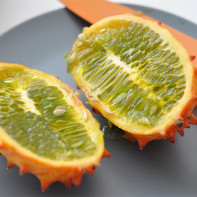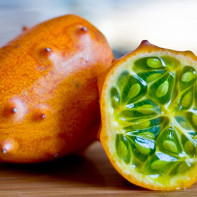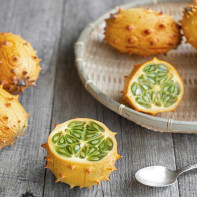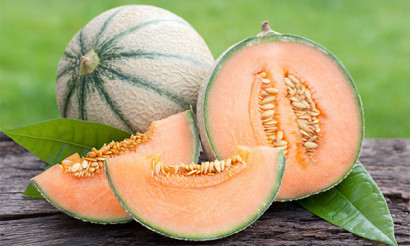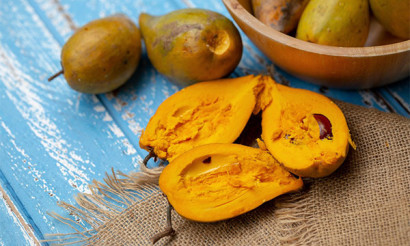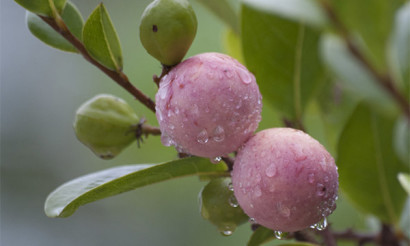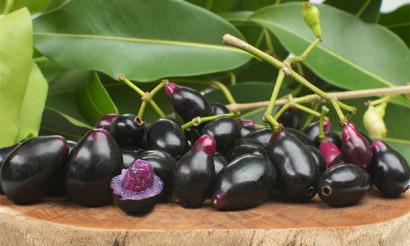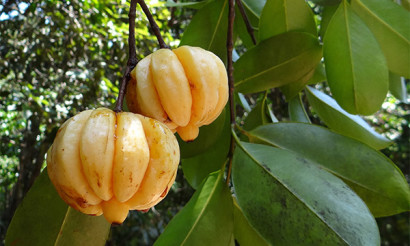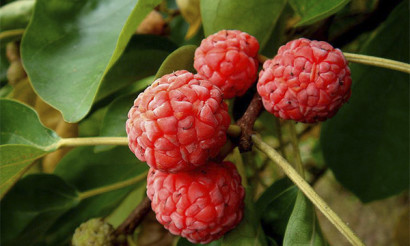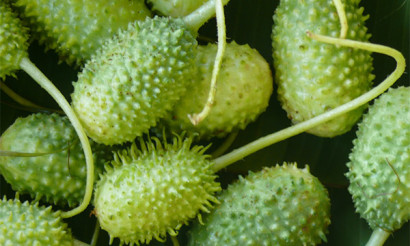Kiwano: what kind of fruit is it and how is it healthy
Uncultivated horned melon creepers, reaching three meters in length, are of two morphological types. The first ones bring bitter fruits, and the second - sweet ones. In appearance, the varieties do not differ.
What is this fruit
Kiwano is an exotic fruit belonging to the Pumpkin family. It is also called horned or jelly melon and African cucumber. The plant does not tolerate sharp temperature fluctuations, likes a warm climate.
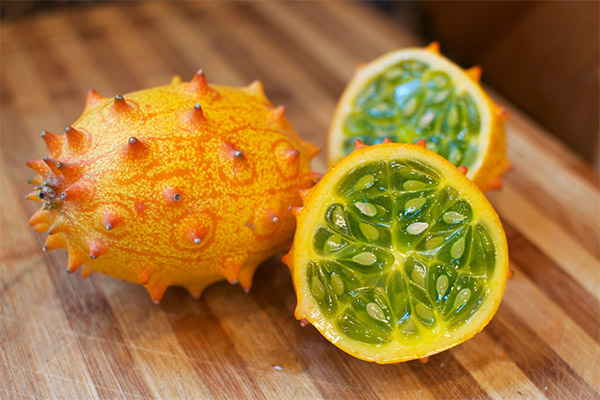
Climbing plants of the first type grow mainly in the territory of South Africa and quite often cause acute poisoning. The degree of bitterness depends on the age of the fetus and the concentration of special substances - cucurbitacins. Young fruits have a slightly unpleasant taste. The fruits contain triterpen, which has an antitumor effect.
The original nickname - horned melon - was due to the dense bright spiked surface of the fruit. A kiwano is called an African cucumber because its green flesh has numerous seeds.
What does it look like
Cultivate the African cucumber to get edible fruits. The fruits look like small oval oranges with soft spikes on the sides. Fruits have a pronounced yellow, orange or red color and an inedible hard peel.
The flesh of salad color is 90% water, it is jelly-like. Calorie content per 100 g is 44 units, and the ratio of protein-fat-carbohydrate is 8/3/6 g. In the fruit pulp, numerous intersperses of pale green seeds are observed, each of which is no more than 1 cm. The fruits themselves are about 15 in length. cm, their antennae reach 4–9 cm, and the circumference does not exceed 10 cm. Weight - about 300–400 g.
Horned melon can be called fruit conditionally. From a biological point of view, it is a pumpkin vegetable, a relative of ordinary cucumbers. The taste resembles a watery banana. Fruits are consumed both in a mature and unripe state.
In some African areas, creeper leaves are also used in cooking. The pulp is sprinkled with sugar or salted. In unsweetened salads, it is combined with ordinary spices - salt, pepper and paprika - and lemon juice, added to fruit and milk drinks. Due to the low nutritional value, dietary adherents have fallen in love with horned melon.
Where grows
The birthplace of Kiwano is Africa. The culture is grown in the tropical and subtropical regions of the Sahara, Kenya, Senegal, Yemen and the southern regions of the hot mainland. It is also widely cultivated in countries in the south of the USA and Central America, cultivated in France, Croatia and Israel.
New Zealand became the first country to start delivering horned melons to a wide market. Export has been established since the 80s of the XX century. There the fruits got their name - “kiwano”. Marketers have chosen such a name to successfully market products in Japanese and American markets. After some time, African cucumbers began to be cultivated in the United States, then the regions of Israel and Kenya - for European consumers. Recently, French breeders successfully planted the seeds of the plant and received the first crop.
What is useful Kiwano
The pulp contains many elements that a person needs. In the chemical composition of Kiwano, you can find compounds:
- copper;
- phosphorus;
- sodium;
- gland;
- potassium;
- manganese;
- magnesium.
Also, the fruits are rich in vitamins of groups A and B, ascorbic and folic acid, organic salts of an alkaline nature, P-active substances and healthy carbohydrates.
Jelly melons are one of the lowest-calorie foods that are consumed even with the strictest diets. But they are useful for the walls of blood vessels and the heart, nervous system, liver, kidneys, pancreas and skin. After the introduction of kivano into the diet, the process of purification from toxins and toxins is accelerated. Fruits are recommended to be used for colds, since fruits help increase immunity and strengthen the body's defenses.
Product useful actions are:
- In blood thinning - this is due to the high water content, which prevents the occurrence of cholesterol plaques, as a result, the prevention of coronary heart disease, heart attacks, strokes and thrombosis occurs.
- Lowering blood pressure - useful for rheumatism and hypertension at any stage of development.
- Reducing the amount of harmful glucose is important for diabetes, because the disease is characterized by a sugar level above 6.8 units, and African cucumbers quickly quench the attacks of hunger and thirst that occur with sharp increases in glucose.
- Restoring the water-salt balance - due to the high percentage of water, jelly melons help saturate cells with moisture and oxygen, which means that premature aging and the likelihood of a neoplasm are prevented.
- Improving digestion - dietary fiber envelops the mucous membranes of the stomach and intestines, regenerating them, fiber prevents flatulence, eliminates diarrhea and constipation, normalizes bile flow.
- Normalization of the immune function - ascorbic acid reduces the risk of getting sick during the spread of viruses and infections, improves the general condition of the body and the appearance of the skin - peeling stops.
- Strengthening the walls of joints - magnesium helps in eliminating signs of osteoporosis, arthrosis, bursitis and rheumatism, a sufficient concentration of the element is important during rehabilitation after serious injuries, hypothermia and cartilaginous overstrain.
- Increased hemoglobin levels - due to iron and folic acid, more red blood cells are formed, blood cells suppress the effects of pathogenic bacteria.
Proponents of alternative medicine in African tribes use fruit pulp to stop bleeding or remove traces of burns, because the subcutaneous part of the fruit has an astringent and healing effect.
Which may be harmful
Serious consequences that occur after eating horned melons have not been recorded. At the first intake, you need to be careful to avoid allergic manifestations, because Kiwano is exotic and unusual for the body. Especially treat a fruit with caution should be a person suffering from food allergies.
Limit the use of fruit:
- with gastritis;
- inflammation of the mucous membranes of the mouth;
- stab;
- hypotension.
If after the African cucumber has been eaten, no changes have occurred, then you can safely enjoy the new taste.
How to choose
When buying a Kiwano, you should pay attention to its shade. Juicy fruits have a bright orange color. Preference should be given to medium-sized fruits, they should be free from damage and stains. Ripe horned melons can be eaten right away. If transportation is planned, then slightly green immature specimens are bought. After 5-7 days, the fruits ripen and delight with freshness.
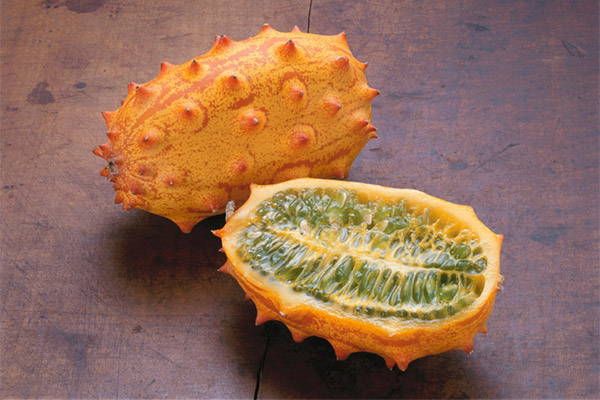
Allowed long storage of African cucumbers, just select a cool place. Fruits ripen faster in sunny places. Each describes taste in its own way. The first recognize the combination of melon and cucumber, the second - banana and lime, the third - apples and kiwi.
Kiwan peel is also used for decorative purposes.The shell is removed from the pulp and dried. Get the original dessert containers. And if you don’t divide the fruits in half, but simply cut off the tops, you will get unusual cocktail vessels.
How to eat Kiwano
Since the taste sensations vary, it is better to buy and try an exotic kivano. To do this, ripe fruit is washed, cut in half and eaten with a spoon. Their consistency is jelly-like. Not quite ripe fruits are cut into slices with a knife and seasoned with spices.
In addition to eating raw, African cucumbers are added to jams and compotes. Due to the unexpressed taste of the pulp, sweet, salty or sharp shades are given to it at will. Kiwano is pleasant in any interpretation: in juices, main dishes, sandwiches, snacks and desserts. At home, the fruits are used in combination with tomatoes, radishes and sweet peppers, with light mousse creams or in pickled form.
What can be made from kiwano
Horned melon is suitable for creative dishes and for those who want to try something new. Gourmets fell in love with a tropical fruit because of its peculiar texture and unusual taste.
Delicate sorbet
Based on 4 servings:
- Kiwano - 1 pc.;
- freshly squeezed orange juice - 200 ml;
- condensed milk - 65 g;
- coconut liquor - 1 tsp;
- natural yogurt - 100 g.
Cooking:
- In a deep bowl, mix all the ingredients, preliminarily chopping the flesh of the jelly melon and relieving the squeezed orange from the seeds. Sent in the refrigerator for 3-4 hours.
- Beat the workpiece with a blender to a uniform consistency. Pour into a container and put in the freezer.
- With an ice cream spoon we form balls from the frozen mixture, pour with our favorite syrup and serve.
Fancy soup
Based on 4 servings:
- jelly melon - 5 pcs.;
- smoked bacon - 150 g;
- pure water - 500 ml;
- pork ribs - 250 g;
- chicken - 320 g;
- salt, garlic, spices, herbs - optional.
Cooking:
- First of all, we make kiwan juice - remove the peel, get the seeds and knead. Add water, whisk with a blender - lumps should be completely dissolved. We filter the juice and discard the cake.
- Boil over medium heat for 1.5–2 hours and add all meat ingredients. But first, chop the bacon and chicken.
- Salt and add spices, chopped garlic. Bring to readiness within an hour. Sprinkle with herbs and serve.
Application in cosmetology
Exotic fruit has spread in cosmetology. Well-known companies use jelly melon in the care products for the eyelids, neck and face. You can make a nourishing mask yourself.
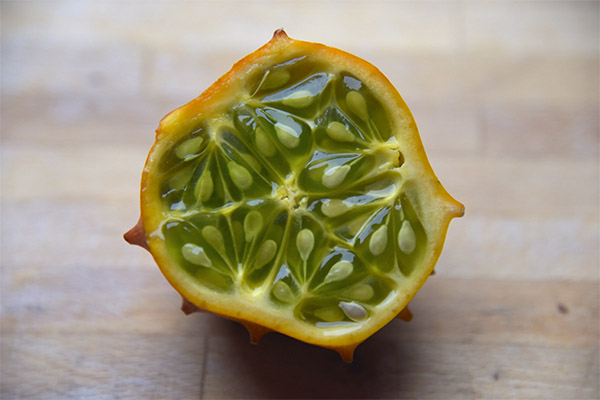
You will need:
- Kiwano - 1/2 pcs.;
- sour apple - 1/2 pcs.;
- honey - 20 g;
- clay - 25 g;
- egg yolk - 1 pc.
Cooking:
- Rub the apple on a fine grater. We clean the horned melon, take out the seeds and knead with a fork.
- Mix the crushed ingredients with honey, clay and yolk.
- The resulting homogeneous gruel is evenly applied to the face skin with massage movements - light tapping or stroking activates the work of the particles, which increases the effectiveness of the procedure.
- After 15-20 minutes, rinse with warm water and apply a moisturizer.
How to grow Kiwano
If you managed to choose a ripe fruit of jelly melon, then you can wash the seeds and plant them in mid spring. The plant will take root in the apartment, if proper care is provided. We select only whole and large seeds. Landing of the latter is carried out in several stages:
- Soak in an aqueous solution of sodium humate or in Epina-Extra fertilizer.
- After swelling, we shift it to a warm place for three days and wait for a punch - this will increase the likelihood of germination.
- Planted in nutrient soil to a depth of 3.5-4 mm.
- We cover the pots with foil and wait for seedlings.
- Water the sprouts regularly.
When growing Kiwano, it is necessary to observe some rules for care:
- We maintain the temperature regime of 20–25 ° C.
- Using a fluorescent lamp, we provide a long daylight hours.
- Protect from direct sunlight, otherwise - spots and burns form.
- Loose every 2-3 days.
After a month, the shoots can be planted in open ground. Young shoots grow and sprawl very quickly, it is preferable to place a horned melon along fences or flat surfaces. We place holes in the size of 40x35 cm in increments of 70-100 cm. The root system of the plant is located close to the surface and will not withstand droughts and stagnation of water. The optimal watering regime is a couple of times a week, provided the weather is not very hot. If the soil is covered with crust, then in the morning or in the evening we carry out loosening.
For a plentiful harvest, we fertilize the soil every 10 days with mineral and organic fertilizing. The fruits are plucked after they acquire a bright orange hue. With proper care, a Kiwano per season produces about 200–250 fruits stored for up to six months. To stock up with jelly melons, fruits canned with salt or sugar.
«Important: all information on the site is provided exclusively in fact-finding purposes. Before applying any recommendations, consult with a profile specialist. Neither the editors nor the authors are liable for any possible harm caused materials. "


